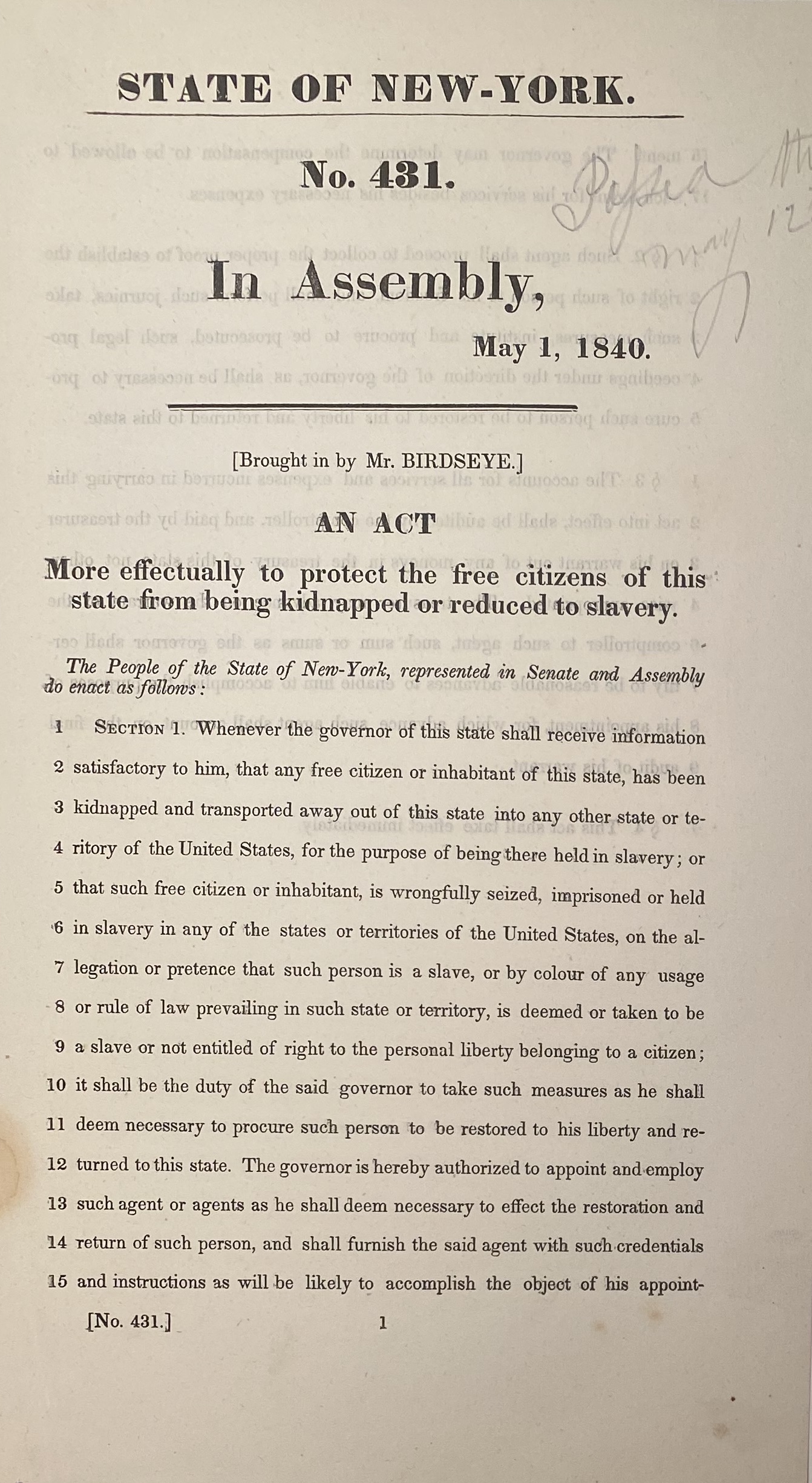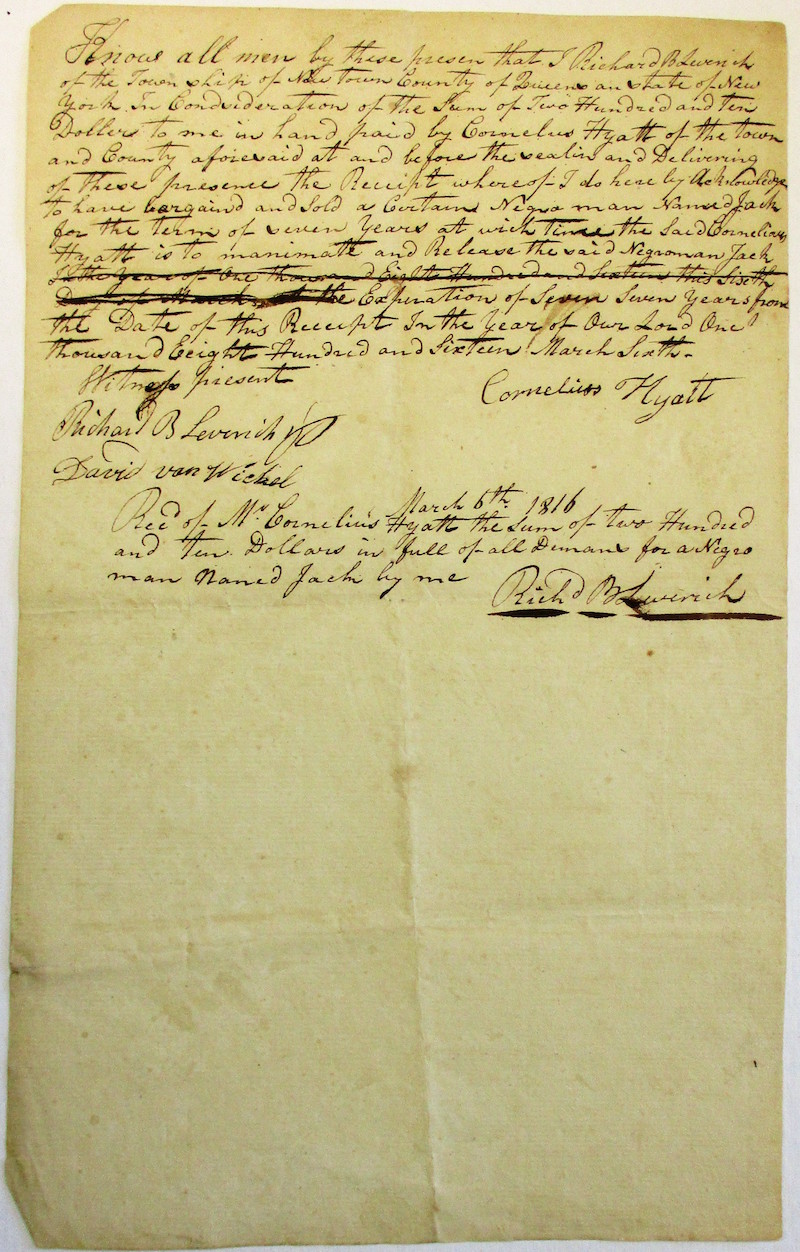the struggle to end slavery in New York
(ABOLITION OF SLAVERY IN NEW YORK.). A collection of four printed and manuscript items relating to the end of slavery in New York
New York, 1816-1840
Four items.
This collection documents the struggle to end slavery in New York in the early nineteenth century. In the 1790s about two-thirds of blacks in the state of New York were slaves. The coming decades brought a hard-fought, gradual struggle to end slavery in the state. In 1799 New York became the next-to-last Northern state to pass an emancipation law. That act declared that all children born into slavery there after July 4, 1799 would be free when they turned 25 (for women) or 28 (for men). Those born before 1799 were redefined as indentured servants for life, to work without pay but not subject to being sold. In 1817 New York finally agreed to free enslaved people born prior to 1799, but it delayed their emancipation for ten years. Slavery in New York State did not come to a complete legal end until July 4, 1827.
The collection comprises:
Sale and ultimate manumission of Jack, a slave in New York in 1816
Cornelius Hyatt and Richard Leverich. Manuscript document selling and then freeing a slave in New York: “Negro Man Named Jack.” [Newtown, Queens, New York,] March 6, 1816. One page, ink on paper. Signed by Richard Leverich, Cornelius Hyatt, and David Van Wickel as witness.
This document vividly reveals the precarious nature of life and the tantalizing hope of freedom for enslaved New Yorkers. Leverich sells his Negro slave Jack to Hyatt for $200, for a term of seven years, after which Hyatt must emancipate Jack. The document states in part,
“… I Richard B. Leverich of the town ship of Newtown County of Queens and state Of New York in consideration of the sum of two hundred and ten dollars to me in hand paid by Cornelius Hyatt … the receipt whereof I do here by acknowledge to have bargained and sold a certain Negro man named Jack for the term of seven years at wich time the said Cornelius Hyatt is to manimatte [sic] and release the said Negro man Jack ….
Jack himself would likely have little power to enforce the agreement to free him. He remained subject to the whims of his new owner. Slavery would not come to an end in New York until 1827.
Freeing enslaved people born before July 4, 1799
Public Laws of the State of New York, Passed at the Fortieth Session of the Legislature (1817). Original boards.
Contains the landmark Act Relating to Slaves and Servants granting freedom to enslaved men and women in New York born before 1799. This act heralded the abolition of slavery in New York, albeit not for another decade after it was passed.
Freedom codified
Revised Statutes of the State of New-York (1829, 3 vols). Contemporary calf. First edition. This is the famous first codification of the laws of New York. Jurist James Kent declared these “the most extensive innovations which have hitherto been the consequence of any single legislative effort.”
The Revised Statutes states, in section 16 of Title VII, that “every person born within this state, whether white or coloured, is free; every person who shall hereafter be born within this state, shall be free; and every person brought into this state as a slave, except as authorised by this Title, shall be free” (Vol. I, p. 659).
New York’s Personal Liberty Law of 1840
New York Assembly. “An Act More effectually to protect the free citizens of this state from being kidnapped or reduced to slavery.” May 1, 1840. 2 pp., Approx. 7 x 12 ½ in.
This is the original printing of the bill that, two weeks later, became New York’s Personal Liberty Law of May 14, 1840, authorizing the governor to appoint agents to recover persons kidnapped and sold as slaves. The bill states in part, “Whenever the governor of this state shall receive information satisfactory to him, that any free citizen or inhabitant of this state, has been kidnapped and transported away out of this state … for the purpose of being there held in slavery … it shall be the duty of the said governor to take such measures as he shall deem necessary to procure such person to be restored to his liberty and returned to this state.”
The law was famously invoked in the case of Solomon Northup, who gained fame as the author of Twelve Years a Slave. In 1841 Northrup was kidnapped in Washington, D.C. and sold into slavery in Louisiana. After a decade in chains Northrup finally found a chance to write to friends in New York who had no idea he was still alive. In 1853 a friend and attorney went to Louisiana under authority of this law, with the approval of New York’s governor, and secured Solomon’s freedom. He published his story as Twelve Years a Slave, with a copy of this law in an appendix. The law was employed several other times in the late 1850s to rescue New York citizens from slavery.
4 items: $12,500




